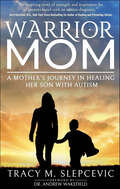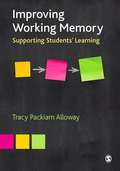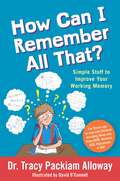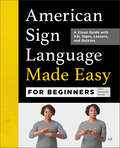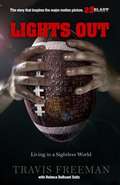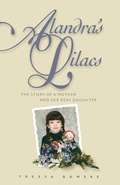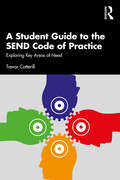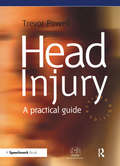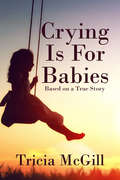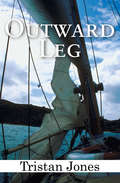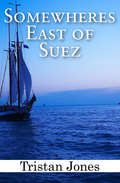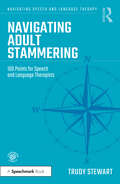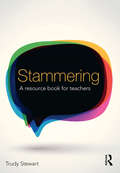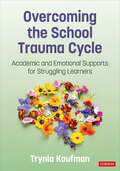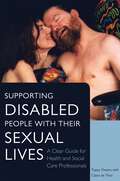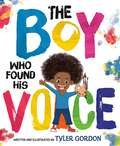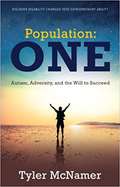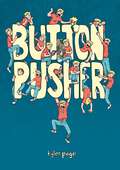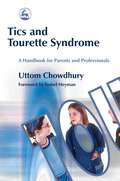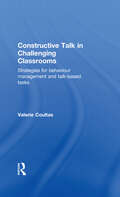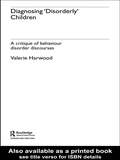- Table View
- List View
Warrior Mom: A Mother’s Journey in Healing Her Son with Autism
by Tracy M. SlepcevicModern medicine considers Autism to be an “incurable diagnosis,” but Warrior Mom challenges this claim, sharing one mother’s journey to heal her son.For any parent who has heard the chilling words "your child has autism," Tracy Slepcevic offers hope, inspiration, and advice to help you navigate the system, evaluate different treatment options, and heal your child’s underlying conditions. After her son Noah had a severe regression after meeting all his milestones, Tracy spent years trying to figure out what was wrong with her little boy. Once given a diagnosis, doctors said Noah would never lead a fully functioning life, but Tracy knew this was not her son’s fate. Refusing to give up, Tracy read dozens of books, attended autism conferences, and spent countless hours researching how to heal her child. She was determined to turn her son around from what doctor’s called an “incurable diagnosis” so that Noah could live his best life possible. Over the years, Noah made great progress with biomedical intervention and lives a fully functional life today with a bright future ahead of him. Warrior Mom is an inspiring story of hope and an indispensable guidebook for any parent desperate to hear the truth that autism is not a hopeless diagnosis and that many underlying conditions associated with autism are treatable.
Improving Working Memory
by Tracy Packiam AllowayYour working memory is the information your brain stores for a short period of time, it is your brain's post-it note if you like, and how much information you can remember has a huge influence on how well you do at school, and beyond. By understanding a child's working memory, you will be able to support their learning at school, and their concentration. Better working memory can be particularly useful to children with conditions where poor working memory is thought to be an underlying factor. Such conditions include: - dyslexia - dyscalculia - speech and language difficulties - developmental coordination disorders (motor dyspraxia) - ADHD (attention deficit hyperactivity disorder) - autistic spectrum disorders This book explains how to spot problems early, and how to work with children to improve their working memory, therefore increasing their chances of success in the classroom. It also explains the theory behind working memory. Underpinned by rigorous research and written in a highly accessible style, this book will appeal to practitioners, parents and students as an essential guide to helping their students fulfil their maximum potential.
How Can I Remember All That?: Simple Stuff to Improve Your Working Memory
by Tracy Packiam Packiam AllowayWhy can't I remember what my parents just asked me to do? Why do I feel stressed out at school when the teacher is writing on the board and talking at the same time? And what can I do about it? Working memory issues affect a huge proportion of kids with learning differences like ADHD, dyslexia, dyscalculia, and ASD. These issues can make them feel frustrated or bored, as working memory and intelligence are two very different things. Kids with working memory problems can also act out in the classroom and at home. In this child-friendly and authoritative guide, international working memory expert Dr Tracy Packiam Alloway walks you through what working memory is, what it feels like to have problems with your working memory, and what you can do about it. She presents key tips and strategies, such as the benefits of eating chocolate or of barefoot running, that will help children both at home and at school, and includes a section at the end for adults describing how we can test for working memory issues.
American Sign Language Made Easy for Beginners: A Visual Guide with ASL Signs, Lessons, and Quizzes
by Travis Belmontes-MerrellLearn American Sign Language the easy way! Become a lifelong learner of American Sign Language (ASL) with this guide for true beginners. It breaks down ASL fundamentals and gives you step-by-step instructions for signing more than 400 vocabulary words, organized by practical topics like greetings, hobbies, times, places, and more.The building blocks of ASL—Lay the foundation for ASL learning as you explore the five parameters of signing: handshape, location, movement, palm orientation, and non-manual markers.Clear guidance for novices—Learn how to sign each vocabulary word with the help of detailed written directions and large, full-color photos, so you know you're doing it right even if it's your first sign ever.Lessons and quizzes—Put your new skills to the test with themed lessons designed for real-world conversations, and brief quizzes at the end of each section.Make learning ASL fun and easy with this top choice in American Sign Language books for beginners.
Lights Out
by Travis FreemanWhen the lights go out - play harder. Travis Freeman plunged into a world of darkness at 12 years old. A rare occurrence of a routine illness stole his sight, leaving the small-town Kentucky boy's dreams of football and fun languishing on the sidelines. Having given his heart to Jesus merely a year before the illness, Travis knew one thing: God was still the light for his life. That life story is now the inspiration for a major motion picture, ""23 BLAST"" that hits theatres in October 2014.
Alandra's Lilacs: The Story of a Mother and Her Deaf Daughter
by Tressa BowersWhen, in 1968, 19-year-old Tressa Bowers took her baby daughter to an expert on deaf children, he pronounced that Alandra was "stone deaf," she most likely would never be able to talk, and she probably would not get much of an education because of her communication limitations. Tressa refused to accept this stark assessment of Alandra's prospects. Instead, she began the arduous process of starting her daughter's education. Economic need forced Tressa to move several times, and as a result, she and Alandra experienced a variety of learning environments: a pure oralist approach, which discouraged signing; Total Communication, in which the teachers spoke and signed simultaneously; a residential school for deaf children, where Signed English was employed; and a mainstream public school that relied upon interpreters. Changes at home added more demands, from Tressa's divorce to her remarriage, her long work hours, and the ongoing challenge of complete communication within their family. Through it all, Tressa and Alandra never lost sight of their love for each other, and their affection rippled through the entire family. Today, Tressa can triumphantly point to her confident, educated daughter and also speak with pride of her wonderful relationship with her deaf grandchildren. Alandra's Lilacs is a marvelous story about the resiliency and achievements of determined, loving people no matter what their circumstances might be.
A Student Guide to the SEND Code of Practice: Exploring Key Areas of Need
by Trevor CotterillIn this essential textbook for students, Trevor Cotterill delves into the four broad areas of need identified in the SEND Code of Practice (2015), providing a spotlight on current research into a range of identified difficulties as well as outlining the appropriate pedagogical approaches required to support these needs in children and young people. Closely mirroring the SEND Code of Practice (2015), each distinct area of need associated with cognition and learning, communication and interaction, physical and sensory issues and social, emotional and mental health difficulties features essential overviews of research and current thinking within each area. Supported with case studies, learning objectives and reflection points, this text includes discussions on autistic spectrum disorders, profound and multiple learning difficulties, ADHD, mental health, physical and sensory difficulties and adverse childhood experiences as they relate to the SEND Code of Practice (2015). Fully endorsed by evidence-based research involving children, young people, adults and their families, this text encourages students to understand that SEND is a complex area and provides opportunities to reflect on previous experience, harnessing them with knowledge for future practice. Concise yet rigorous in its explanations and coupled with signposted activities and suggestions for further reading throughout, A Student Guide to the SEND Code of Practice will be invaluable to undergraduate students undertaking a programme of study incorporating special educational needs and disability as a single or joint honours.
Head Injury: A Practical Guide (Speechmark Editions)
by Trevor PowellThis popular and bestselling book has been brought up to date with the latest information on caring for someone with a head injury. Newly published, it includes an additional chapter on long term emotional adjustment, plus extended sections on other types of brain injury, returning to work, anger management and improving insight and awareness. This book is the ultimate guide to the hidden psychological, social, behavioural and emotional problems caused by head injury for professionals, families and carers. Practical, down-to-earth and written in a jargon-free style, it addresses the medical problems, rehabilitation and adjustment of individuals and families to the realities of life after head injury. Containing personal experiences, factual information and research and specific guidance and practical advice on ways of dealing with difficulties connected with head injury, this new and updated version will be an essential addition to the resources of all professionals working with people with a head injury.
Crying is for Babies: Based on a True Story
by Tricia McGillIn the 1930s medicine was still very much a hit and miss affair. The surgeons were still experimenting and learning about the human body. This at a period when there was little in the way of pain relief. This is one woman’s story about a childhood ruined by such surgeons, whose bad judgement confined an eight-year-old subsequently to bed for three years and left her with a disability to last a lifetime. Nowadays she would have been given bed rest and pain relief, and in no time would have been up and running again. Her strong will, and the love of a close family, saw her through the bad times, enabling her to go on and become the talented, remarkable person she was. I know because this woman was my sister.
Ellie and the Marriage List
by Tricia SeaboltEllie is ready to have the best summer ever. She's especially excited to draw under her favorite tree and hang out with her big brother, Ben. But all Ben seems to care about is impressing the new lip-glossy neighbor, Sara. And all Sara seems to care about is turning Ellie's brother into a Hawaii husband! Luckily, Ellie's best friend, Ling, has the marriage list—a top-secret tool to track the lovebirds and stop a wedding before it starts. But nothing goes to plan, and while trying to rescue Ben, Ellie ends up putting the weeping willow in her garden in danger. Faced with losing everything she loves most, can Ellie find a way to win back her brother and save her beloved tree? An utterly charming story about a lovable 10-year-old with Down syndrome whose extra sparkle never fails to shine bright.
Outward Leg
by Tristan JonesAfter seven years ashore and after having his left leg amputated, Tristan Jones decided to return to the sea. He began to piece together Operation Star and found the perfect vessel in a 36-foot trimaran. In October 1983, Jones and his only crew member, Wally Rediske, set out in Outward Leg from San Diego, intending to circumnavigate the world from west to east by sail.The book is the exciting story of Tristan's preparation for this major seagoing event and the chronicle of half of it. Tristan sailed down the western coast of Central America through the Panama Canal to a small Colombian town. There he had to fight for survival among hostile natives, drug dealers, and uncooperative port officers. He went on to Venezuela, Aruba, and the Dominican Republic during its 1984 revolution. Finally he reached New York and crossed the Atlantic to return to St. Katharine's Dock in London where he began his seagoing life thirty years before.
Somewheres East of Suez (Sheridan House Ser.)
by Tristan JonesIn 1983 Tristan Jones, well known as one of the finest sailing adventure writers of our time, had his left leg amputated. Refusing to become landbound after a lifetime at sea, he acquired a specially designed, virtually untippable 38-foot trimaran and began to sail around the world. Outward Leg is the tale of his intrepid voyage from San Diego to London. The Improbable Voyage chronicles his heroic journey along an unusual and hazardous route from the North Sea, through the rivers of Central Europe, to the Black Sea. In Somewheres East of Suez, the final installment of this extraordinary saga, Tristan sails eight thousand miles from Istanbul to Thailand. From the tourist- and terrorist-dominated ports of the eastern Mediterranean to African outposts peopled with famine refugees, Tristan maintains the unique perspective of a man who has had minimal contact with society's restraints, using his acerbic wit to spare no fools and offer biting social commentary. After barely escaping with his life in South Yemen, he sets off for the Far East, determined to win out against the difficulties of his disability, whether battling a tropical cyclone or surviving on a dwindling ration of fresh water in the vast windless expanse of the Indian Ocean.
When Rabbit Howls
by Truddi ChaseThis is the true story of Truddi Chase, a woman who developed more than ninety personalities in order to cope with the horrendous abuse she suffered at the hands of her stepfather.
Navigating Adult Stammering: 100 Points for Speech and Language Therapists (Navigating Speech and Language Therapy)
by Trudy StewartThis book, the first in an exciting new series, provides speech and language therapy students and newly qualified and beginning stammering specialists with 100 key points that will help form a strong foundation for their work supporting adults and teenagers who stammer. Composed of practical, relevant and useful advice from an experienced clinician, chapters break advice down into sections which include information about the therapeutic relationship, therapeutic approaches and signposts to further resources. Throughout the book, comments from stammering specialists describe what they wish they had known at the start of their careers. This book: Puts the person who stammers at the heart of therapy, following the clinical choices they might make Is written in an accessible style, designed to be dipped in and out of as required Draws on the experience of therapists working with those who stammer Full of advice and guidance to support effective practice, this is an essential resource for anybody new to this client group.
Stammering: A resource book for teachers (Overcoming Common Problems Ser.)
by Trudy StewartWhat is stammering? How does it present itself? When does it occur? Why does it happen? What are the most effective strategies you can use to help? Providing background information about stammering as well as a wide range of tools and strategies, this practical book addresses the key challenges faced at nursery and school. There are separate sections on early years, primary and secondary level and include the most common areas that teachers must consider when supporting children who lack speech fluency, including: identifying children at risk of developing a stammer how to manage incidents of stammering how to manage classroom communication and oral participation helping children to make and maintain relationships help children to manage feelings associated with stammering working alongside speech and language therapists. Recent changes to the curriculum means that there is now a greater demand on children’s communication skills than ever. This book will help you provide the necessary support to a child who stammers by offering a clear explanation of the presentation of stammering and the best ways you manage the occurrence of stammering in a range of school contexts. Full of tips and advice this book will enable teachers and other professionals to work effectively with a child who stammers. This accessible book is essential for anyone concerned about a child in their care who presents with a stammer, including teachers, student teachers, SENCOs and parents.
Overcoming the School Trauma Cycle: Academic and Emotional Supports for Struggling Learners
by Trynia KaufmanDisrupt the painful cycle of academic challenges and emotional distress When students struggle with learning, it can be stressful for both them and their teachers. Struggling learners are more likely to experience low self-esteem, anxiety, depression, and behavioral issues—challenges that, combined with highly stressful learning experiences, can tip students into a trauma response that makes learning even harder. Overcoming the School Trauma Cycle explores the science behind how learning occurs in the brain, how it can be disrupted, and—most importantly—how to overcome the painful cycle of academic challenges and emotional distress. Inside, you′ll find: What the latest research tells us about how mental health issues can disrupt the learning process How academic and mental health challenges can fuel each other Manageable, whole-class practices and targeted supports to meet struggling learners’ academic and emotional needs Opportunities to self-assess and reflect Many schools have increased their focus on trauma-informed teaching and social-emotional learning, but these approaches are too often pitted against academic rigor when they are really two sides of the same coin. To improve outcomes for all students, we must address their social-emotional needs alongside their academic ones. In Overcoming the School Trauma Cycle, you′ll discover empowering practices to help all students learn and thrive.
Overcoming the School Trauma Cycle: Academic and Emotional Supports for Struggling Learners
by Trynia KaufmanDisrupt the painful cycle of academic challenges and emotional distress When students struggle with learning, it can be stressful for both them and their teachers. Struggling learners are more likely to experience low self-esteem, anxiety, depression, and behavioral issues—challenges that, combined with highly stressful learning experiences, can tip students into a trauma response that makes learning even harder. Overcoming the School Trauma Cycle explores the science behind how learning occurs in the brain, how it can be disrupted, and—most importantly—how to overcome the painful cycle of academic challenges and emotional distress. Inside, you′ll find: What the latest research tells us about how mental health issues can disrupt the learning process How academic and mental health challenges can fuel each other Manageable, whole-class practices and targeted supports to meet struggling learners’ academic and emotional needs Opportunities to self-assess and reflect Many schools have increased their focus on trauma-informed teaching and social-emotional learning, but these approaches are too often pitted against academic rigor when they are really two sides of the same coin. To improve outcomes for all students, we must address their social-emotional needs alongside their academic ones. In Overcoming the School Trauma Cycle, you′ll discover empowering practices to help all students learn and thrive.
Supporting Disabled People with their Sexual Lives: A Clear Guide for Health and Social Care Professionals
by Tuppy OwensMany health and social care professionals today feel untrained, fearful and ill-equipped to support their disabled patients, clients and service users in their sexual lives. The result is that disabled people can be left feeling frustrated and afraid that their sexual needs will be forever unrecognised and unmet. This is a straight-talking guide to supporting disabled people with their sexual lives. It covers the range of difficulties disabled people experience, from physical limitations to problems such as lack of acceptance, knowledge and skills. The real difficulties professionals experience are also covered with positive suggestions, and a chapter on communication discusses how to discuss sex. Sections follow on the sexual services available to help, and the wide range of sexual diversities which disabled people can and do enjoy. A chapter by Claire de Than covers the law. This clear, down-to-earth guide will be essential reading for all those working with or supporting disabled people, from care home workers and managers to social workers, medical staff and therapists.
The Boy Who Found His Voice
by Tyler GordonFrom teen activist and artistic prodigy Tyler Gordon comes a heartwarming picture book inspired by his own life about a boy with a speech difference who learns the power of self-expression through art.There once was a young boy who had trouble with words. He paused and stuttered and stammered, which made school really tough. But with encouragement from his mom and a paintbrush in hand, he learns that finding your voice isn’t about being perfect—it’s about being true to yourself.For fans of I Talk Like a River and Amanda Gorman, The Boy Who Found His Voice is a joyful and empowering testament to art, empathy, and having self-confidence even in the face of doubt.Don't miss Tyler Gordon's bold picture book debut We Can: Portraits of Power.
Population One: Autism, Adversity, and the Will to Succeed
by Tyler McNamerBeing different from the masses is one of the greatest gifts that you possess! Let s face it: Who wants to be just like everyone else? Talk about boring! People come in all shapes and sizes and are born with natural and unnatural gifts and talents like no other, and your greatest challenge is to discover your gifts and then apply them to the world to create a better place, a better planet, a better universe! That is my challenge to you so that all of us can get along peacefully and become truly a population of one. I would like to ask you some questions to help you discover what makes you unique, different, and awesome. Are you different? Are you unique? Do you look different than others? Talk differently than others? Do you walk differently than others? Have you been born with talents that very few others have? Have you been brainwashed to look at your talents as a disability? Do you stay up nights dwelling on all the things in life you don t have, rather than focus on all the blessings you do have? Have you ever been bullied at school, at home, and in many areas in your life? Have you ever been called a retard, dumb, disabled ? If you have answered yes to any of these questions, perhaps you have yet to understand, accept, and apply your unique gifts to make the world a better place. If you have answered Yes to any of these questions, I feel your pain, I have walked in your shoes, and I can empathize with your situation. I have been bullied, called a retard, told that I am disabled, put in special classes, advised that I should not expect to reach my goals. My name is Tyler McNamer and I have been called ALL of the above many, many times in my life.
Button Pusher
by Tyler PageA memoir-driven realistic graphic novel about Tyler, a child who is diagnosed with ADHD and has to discover for himself how to best manage it. <P><P> Tyler’s brain is different. Unlike his friends, he has a hard time paying attention in class. He acts out in goofy, over-the-top ways. Sometimes, he even does dangerous things—like cut up a bus seat with a pocketknife or hang out of an attic window. <P><P> To the adults in his life, Tyler seems like a troublemaker. But he knows that he’s not. Tyler is curious and creative. He’s the best artist in his grade, and when he can focus, he gets great grades. He doesn’t want to cause trouble, but sometimes he just feels like he can’t control himself. <P><P> In Button Pusher, cartoonist Tyler Page uses his own childhood experiences to explore what it means to grow up with ADHD. From diagnosis to treatment and beyond, Tyler’s story is raw and enlightening, inviting you to see the world from a new perspective. <P><P><i>Advisory: Bookshare has learned that this book offers only partial accessibility. We have kept it in the collection because it is useful for some of our members. Benetech is actively working on projects to improve accessibility issues such as these.</i>
Invisible Me
by Tzipi CatonA teenage girl is a selective mute. Her teachers think she's rude, her classmates think she's weird, and her siblings call her "socially suicidal." She must navigate her way through a new school, and a rocky relationship with her mother, and classmates who act as if she doesn't exist.
Tics and Tourette Syndrome: A Handbook for Parents and Professionals
by Uttom ChowdhuryThis essential guide to tic disorders and Tourette Syndrome tackles problems faced both at home and at school, such as adjusting to the diagnosis, the effect on siblings and classroom difficulties. Dr Chowdhury offers advice on how to manage symptoms, describing practical techniques such as habit reversal and massed practice and reviewing available medical treatments. In clear, accessible language, this book explains the clinical signs and symptoms of Tourette and related conditions, and their possible causes. Presenting strategies for dealing with associated difficulties, including low self-esteem, anger-management and bullying, this book will be invaluable to parents, teachers, social workers and other professionals.
Constructive Talk in Challenging Classrooms: Strategies for Behaviour Management and Talk-Based Tasks
by Valerie CoultasConstructive Talk in Challenging Classrooms gives the practising teacher advice on how to make learning fun through the use of ‘talk’ and collaborative group work. Using clear examples, tried and tested in some of the most challenging classrooms in inner city schools, the book offers practical and honest advice on both the difficulties and rewards that can be gained when employing all forms of talk-based teaching in the classroom. Packed with real examples of successful talk based lessons with children of all abilities and needs, this book will show teachers how they can succeed in overcoming problems of disruption and engage even the most difficult pupils in real learning through talk. The book shows that bringing the child's individual experience into a lesson through talk has huge emotional and psychological benefits – this can be particularly marked in classrooms where there are low levels of literacy, behaviour issues or where pupils’ first language is not English. The author argues that talk is vital for building positive relationships and essential for successful teaching, particularly in the difficult classrooms. This inspiring title is essential reading for any teacher interested in building trust and making learning fun and meaningful for all.
Diagnosing 'Disorderly' Children: A critique of behaviour disorder discourses
by Valerie HarwoodBased on the author's in-depth research with children diagnosed with behavioural difficulties, this book provides a thorough critique of today's practices, examining: the traditional analyses of behavioural disorders and the making of disorderly children the influence of the 'expert knowledge' on behavioural disorders and its influence on schools, communities and new generations of teachers the effect of discourses of mental disorder on children and young people the increasing medicalisation of young children with drugs such as Ritalin. This book offers an innovative and accessible analysis of a critical issue facing schools and society today, using Foucaultian notions to pose critical questions of the practices that make children disorderly. Rich in case studies and interviews with children and young people, it will make fascinating reading for students, academics and researchers working in the field of education, inclusion, educational psychology, sociology and youth studies.
